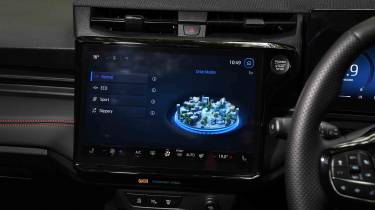Ford Puma - Interior, design and technology
Mid-life updates focus on the Ford Puma’s interior design and a larger infotainment screen

The cabin in the face-lifted Ford Puma has been transformed. Not only has the dashboard been overhauled to accommodate the latest version of Ford’s SYNC infotainment set-up, but the air vents have now moved to the top of the dash from their previous position lower down. The steering wheel is also new, and the slightly squared-off shape is similar to the item used in the latest Transit Custom, but it suits the Puma’s sporty character well.
Sometimes it’s the simplest technology that is the most useful. Ford’s Quickclear heated windscreen, a feature that first appeared on the brand’s models in the 1980s, is still a fantastic feature for the winter months. More recent tech inclusions include the digital dials, which are sharp and clear, but the same can’t be said of the reversing camera, which has a relatively low resolution. The Puma has four USB ports, with one USB-A socket, and the rest being USB-C connections.
What is the Ford Puma like inside?
From an ergonomic point of view, the Puma now features just one steering-column stalk. It’s on the left-hand side and caters for the front and rear wipers, plus the headlight flasher and indicators. The main lighting controls are now adjusted via a panel on the dashboard to the right of the steering wheel.
More reviews
Car group tests
- Ford Puma vs Renault Captur: the big small-SUV showdown
- Ford Puma vs Vauxhall Mokka: two best-selling crossovers clash
In-depth reviews
Road tests
- New Ford Puma facelift 2024 review: best-selling SUV gets welcome upgrades
- New Ford Puma ST Powershift 2023 review
- New Ford Puma ST-Line X Gold Edition 2022 review
Used car tests
A complete cabin redesign was needed so Ford could cram its huge touchscreen into the dashboard. It has slightly raised the level of the dash, so forward visibility isn’t quite as clear as it once was.
There are other ergonomic compromises, too. The new pad to hold a smartphone (or charge it wirelessly) isn’t very well thought out because it leans backwards towards the cabin. While a phone stays in place for the most part, it’d be more secure if it leant forward, away from the gear selector and handbrake.
What is the interior quality like?
The 2024 updates have certainly helped boost the feeling of quality inside the Puma. While a Peugeot 2008 still has most of the competition beaten for material finish, the Ford no longer feels like it lags behind.
There are still some hard plastics dotted around the Ford’s interior, but these aren’t as noticeable as they were before thanks to the leather-effect trim added to the dashboard and door panels.
Sat-nav, stereo and infotainment
The Puma’s SYNC infotainment features Amazon Alexa voice control as part of its interface. But while the system is an improvement over the older version and is fine in isolation, beside the best in this sector, its weaknesses are highlighted. At 12 inches, the display is among the largest in this class. But while it’s big, it’s not quite as clever as we’d hoped.
Compared with the class-leading Renault Captur, the mapping screen isn’t very detailed, and there’s a noticeable delay when booting up. The panel isn’t as responsive to touches as the Renault, either. That’s a big deal, given that the climate settings are entirely adjusted through the screen.
A six-speaker sound system comes as standard with Titanium, but upgrade to ST-Line X, and you’ll get a 10-speaker audio set-up from Bang & Olufsen, plus a wireless smartphone charging pad.
Which Is Best
Cheapest
- Name1.0 EcoBoost Hybrid mHEV Titanium 5dr
- Gearbox typeManual
- RRP£26,350
Most Economical
- Name1.0 EcoBoost Hybrid mHEV Titanium 5dr
- Gearbox typeManual
- RRP£26,350
Fastest
- Name1.0 EcoBoost Hybrid mHEV ST 5dr DCT
- Gearbox typeSemi-auto
- RRP£33,600





